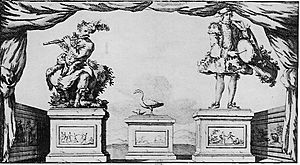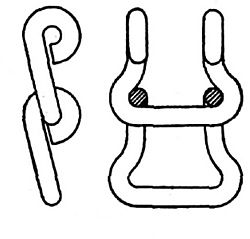Jacques de Vaucanson facts for kids
Jacques de Vaucanson (born February 24, 1709 – died November 21, 1782) was a clever French inventor and artist. He is famous for building amazing automata, which were like early robots. He also created the first all-metal lathe, a very important machine tool. This lathe helped kick off the Industrial Revolution. Vaucanson was also the first person to design an automatic loom.
Contents
Early Life and New Ideas
Jacques Vaucanson was born in Grenoble, France, in 1709. He grew up in a poor family; his father was a glove-maker. When he was young, he wanted to become a clockmaker. He studied with the Jesuits and later joined a religious group called the Minims.
At first, he planned to study religion. But then he met a surgeon named Claude-Nicolas Le Cat. From him, Vaucanson learned a lot about how the human body works. This new knowledge helped him create his first mechanical devices. These machines could copy how living things breathe, circulate blood, and even digest food!
Amazing Automata: Early Robots
When Vaucanson was just 18, he got his own workshop in Lyon. A rich nobleman gave him money to build machines. In 1727, he decided to make some androids, which are human-like robots. These automata were meant to serve dinner and clear tables for visiting officials. However, one official thought Vaucanson's work was "profane" and ordered his workshop to be destroyed.
In 1737, Vaucanson built The Flute Player. This was a life-sized figure of a shepherd. It could play the tabor and the pipe, performing twelve different songs. The figure's fingers were not flexible enough, so Vaucanson had to cover them with a special "skin." He showed this amazing creation to the Académie des Sciences in 1738.
At that time, mechanical creatures were popular in Europe. But most were just toys. Vaucanson's creations were different. They were seen as revolutionary because they were so complex and lifelike.
Later in 1738, he made two more automata: The Tambourine Player and The Digesting Duck. The duck is considered his most famous work. It had over 400 moving parts in each wing! The duck could flap its wings, drink water, and seemed to digest grain.
Vaucanson's duck appeared to digest food. However, it actually had a hidden compartment. What the duck "ate" (water and seeds) was not what it "excreted." It would excrete a mix of bread crumbs and green dye. This looked just like real duck waste to people watching! These kinds of tricks were common. Scientists often needed to entertain rich and powerful people to get their support. While building the duck's intestines, Vaucanson invented the world's first flexible rubber tube. Despite how amazing his automata were, he reportedly grew tired of them and sold them in 1743.
His inventions caught the eye of Frederick II of Prussia, a powerful king. Frederick wanted Vaucanson to work for him. But Vaucanson chose to stay and serve his own country, France.
Serving His Country: Silk and Looms
In 1741, Cardinal Fleury, a top minister for King Louis XV, appointed Vaucanson. He became the inspector of silk manufacturing in France. His job was to improve how silk was made. At that time, France's weaving industry was falling behind England and Scotland.
Vaucanson pushed for big changes to automate the weaving process. In 1745, he created the world's first fully automated loom. He built on the work of earlier inventors like Basile Bouchon and Jean Falcon. Vaucanson wanted to use punch cards to automate the French textile industry. This technology would later change weaving forever. In the 20th century, punch cards were even used to put information into computers!
However, the weavers did not like his ideas. They even threw stones at him in the street! Many of his revolutionary ideas were ignored at the time. In 1746, he became a member of the important Académie des Sciences.
The First Industrial Lathe
In 1760, Vaucanson invented the first industrial metal-cutting slide rest lathe. Some sources say he invented it in 1751. This lathe was described in the famous Encyclopédie. You can still see it at the Musée des Arts et Métiers in France. He designed it to make very precise cylindrical rollers. These rollers were used to press patterns into silk cloth.
Vaucanson's Lasting Legacy
Jacques de Vaucanson passed away in Paris in 1782. He left his collection of work to King Louis XVI. This collection later became the start of the Conservatoire des Arts et Métiers museum in Paris.
Sadly, all of his original automata have been lost. The flute player and tambourine player were reportedly destroyed during the French Revolution. Some of his machines were sold to a glove-maker named Pierre Dumoulin. Dumoulin showed them across Europe with great success. His shows in Saint Petersburg even started a trend of automata in Russia.
Vaucanson's ideas for automating weaving were ignored during his lifetime. But they were later improved and put into action by Joseph Marie Jacquard. Jacquard created the Jacquard loom, which revolutionized the textile industry.
Today, a school in Grenoble, Lycée Vaucanson, is named in his honor. It trains students for careers in engineering and technical fields.
See also
 In Spanish: Jacques de Vaucanson para niños
In Spanish: Jacques de Vaucanson para niños
- The Turk
- Robot
- Animatronics




